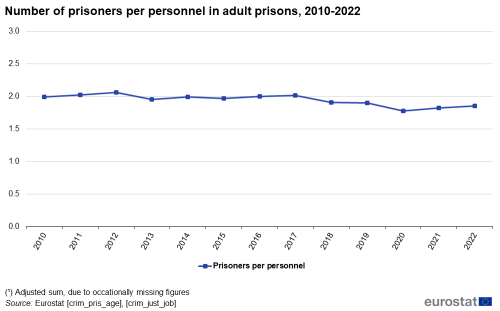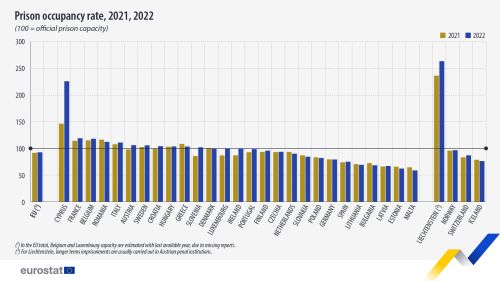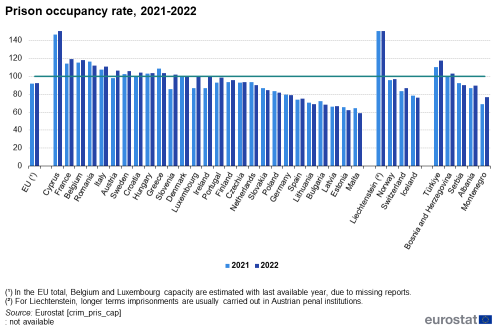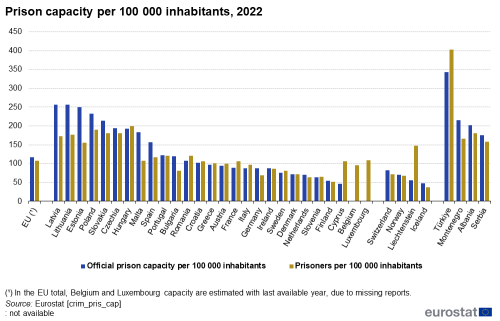Prison occupancy statistics
Data extracted in April 2024.
Planned article update: April 2025.
Highlights
This article presents European statistics on prison occupancy and expenditure. Prisoners' data are presented in the prison statistics article while prison personnel data are presented in the police, court and prison personnel statistics article. Countries' compliance with the classification of crimes and counting methodologies is explained in the crime metadata.
Full article
11 countries experienced overcrowded cells in 2022
The occupancy rate for a prison is the number of prisoners relative to the official capacity (design capacity) of that prison[1], multiplied by 100. Overcrowding can be formally defined as any occupancy rate exceeding 100. However, practical adaptations in the prison can make the safe operational capacity higher than the official capacity. On the one hand, a minor or temporary excess does not necessarily indicate an overcrowding problem. On the other hand, measuring overcrowding in a country with several different prisons may hide local overcrowding.
As shown in Figure 1, 16 countries had some extra capacity, or "empty cells", while 11 countries experienced overcrowded cells in 2022. The highest overcrowding rates [2] in 2022 were observed in Cyprus (225.9), France (119.0), and Belgium (118.1)[3], followed by Romania (112.2) and Italy (111.0). The lowest rate were found in Malta (58.7), Estonia (62.2) and Latvia (67.0). In 16 of the EU countries, the prison occupancy rate increased compared to 2021, when a decrease was probably due to COVID-19-related measures.
Typically, the numbers of prisoners vary more than capacity numbers. Prison capacity cannot be changed rapidly, since it takes time to plan and construct secure buildings. Official prison capacity changes when, for instance, a new prison building is finished, adaptations are made to an existing prison, or a prison is decommissioned. Prisoner numbers depend on other factors, such as conviction rates, lengths of sentences, amnesties and pardons.
One prison place per 856 inhabitants in the EU in 2022
In 2022, there was one place in prison per 856 inhabitants in the EU, or 117 places in prison per 100 000 inhabitants. This value varies considerably from one EU country to another. It is higher in Eastern and Baltic countries especially in Latvia (257.1), Lithuania (256.6), Estonia (250.3), Poland (232.4), and Slovakia (214.4). Prison places per 100 000 inhabitants are much lower in Cyprus (46.9), Finland (53.9), and Slovenia (64.3). Figure 2 shows the figures for prison capacity per 100 000 inhabitants compared to the number of prisoners per 100 000 inhabitants.
1.9 prisoners per prison personnel in the EU
From 2010 to 2017, the average number of prisoners per prison personnel has been around 2.0 in the EU. Then, it decreased in 2018 to 1.9 due to a higher number of prison personnel. In 2020 and 2021 probably due to COVID-19 measures and the consequent reduction in the number of prisoners, the ratio decreased to 1.8 and then recovered to 1.9 in 2022. Typically, the number of prisoners varies more over time than the number of prison personnel, as it takes some time to adjust staff size to the prisoner population.

Source: Eurostat (crim_pris_age) (crim_just_job)
Source data for tables and graphs
Data sources
Data sources for prison statistics are national authorities such as prison administration or the national statistical institute. Eurostat collects prison data together with the yearly UN global crime statistics. All results presented in this article are based on official figures.
Missing data is a major problem for some types of crime statistics at European level. When EU totals are calculated to indicate an overall trend, missing figures for countries are estimated with the last available year (of the same country). However, the EU totals presented in this article are not disseminated in the Eurostat database. The national figures are presented in the web database as reported (no adjustments).
Eurostat updates the web database when countries send new figures, but older statistical articles may refer to previously reported figures.
Context
In general, each country is responsible for its own criminal laws, criminal justice policies, as well as specifications for relevant statistics. Typically, official statistics on crime and criminal justice are made for administrative purposes and used by national authorities.
Prison statistics are part of official statistics on crime and criminal justice, relating indirectly to crime occurrence and the performance of the criminal justice system.
The number of prisoners (counted at the end of a year) depends on:
- the number in previous year
- how many were convicted and actually imprisoned during the year
- how many left prison during the year: released, pardoned, died, escaped, etc.
The trend in prisoner number depends on:
- how many crimes are brought to court
- how many are convicted, and actually sentenced to prison
- length of sentences received, and the actual duration
- alternative sanctions, early release, amnesties, pardons, etc.
- law changes, for which types of crime imprisonment is prescribed, and for how long
Direct access to
See also
Publications
Dedicated section
Notes
- ↑ Source: ‘Handbook on strategies to reduce overcrowding in prisons’, United Nations Office on Drugs and Crime, 2013
- ↑ 100 means that the number of prisoners is equal to the official prison capacity
- ↑ Belgium capacity is estimated with last available data, due to missing reports


